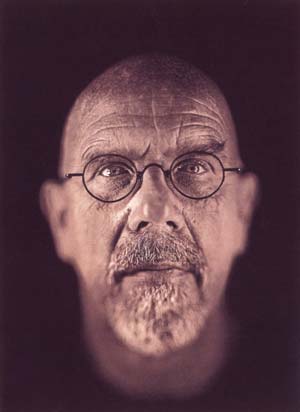 |
 |
 |
 |
 |
 |
Daguerrotype Qualities
A daguerrotype
has an astonishing level of detail and dimensionality that is unsurpassed
by any other photographic method. The
first time Chuck Close saw a daguerrotype,
he was attracted not only to its level of detail, but also to its combination
of poignancy and elusiveness and that it requires the active participation
of the viewer. He remarks, "When you look
at a daguerrotype, your experience does not stop with the imagery but also
involves the physicality of the process." Unless one looks at a daguerrotype
from the right angle in the right light, one sees only a mirror. It is not
a static experience because the plate has to be shifted for the image to be
seen.
The other aspect of the daguerrotype that Close finds interesting is its intimacy. He comments, "There is so much to involve yourself with that you are rooted in a more careful examination. The daguerrotype has the ability to make you fill in the image, and that filling in makes the image almost alive." Close's work is all about the relation of parts to the whole, about focus, and with the daguerrotype, the closer one gets, the more one sees.
 |
| Self Portrait (2000), daguerrotype, 10 x 8 inches, Chuck Close. |
Chuck Close has been painting unique mug-shot style portraits for several decades. Aware that daguerrotypes were traditionally suited to photographing people in the nineteenth century, Close wanted to extend his own ideas about portraiture through using the photographic process himself. Due to his physical disabilities, Close worked with Grant Romer on a first attempt at a daguerrotype in 1997. The results were disappointing because of the uncertainties of the process. Two years later, Close tried again this time working with Jerry Spagnoli (a skilled daguerrotype artist) and achieved more successful results. Close and Spagnoli initially started out using natural light with long exposures, but people's chests moving as they breathed meant that the images came out slightly blurred. So they worked out a way to use strobes and make the exposures instantaneous. Since then Spagnoli has collaborated as an assistant and technician on all of Close's daguerrotype projects including his series of nude portraits.